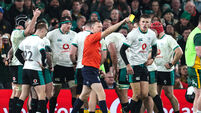When the gift of returned sight becomes a disability
Blindness such as faces many sufferers of retinitis pigmentosa and another of the most common causes of vision loss, macular degeneration.
At the University of Southern California, they’ve invented a bionic eye.
It’s called the Argus II artificial retina, and the regulators in the United States have cleared the way to begin trials with the latest version of the device.
Earlier versions, fitted to people who had already lost their sight, delivered results better than had been expected.
The ophthalmologists anticipated that the participants in the study might perhaps regain the capacity to distinguish light and shade and motion.
They did so. But some regained, in addition, the ability to detect movement around them and the ability to spot the difference between objects in a kitchen like cups and teapots.
In fact, some participants were even able to read outsized letters.
One of the trial participants was even able to see — albeit dimly — the face of his son, which he hasn’t seen for more than seven years.
“It was the first time I had seen him since he was five years old,” the man said. “I don’t mind saying, there were a few tears wept that day.”
The device is effectively a pair of glasses incorporating a miniature camera that transmits images to a radio receiver implanted near the wearer’s eye.
The radio receiver sends on the message to a series of electrodes, and what’s most exciting about the research is that the results achieved thus far came from only sixteen electrodes, whereas the more advanced, smaller “bionic eye” will have 60.
The participants in the first trial included some with macular degeneration, which blinds nearly two out of 10 people over 75 years of age.
With the new technology, they were able to move around a room without colliding with furniture.
It’s important to note that the methodology won’t work for people who are blind because of destroyed optic nerves, as can happen with glaucoma or as a result of a stroke.
Nor is it expected to work for people who have been blind from birth.
It takes a while for the brain to cop on to the significance of the new signals it receives from the camera.
On the other hand, the time taken to implant the connections in someone’s head has gone down from seven hours to less than two.
The professor who’s heading up the research says that if all goes well, the device should be widely available in no more than a couple of years, and should cost in the region of €20,000.
Whereas up to now, those trying to use the bionic eye had to come to terms with it in a laboratory setting, hopes are high that very soon, wearers (or users) will be able to “learn” what it’s telling them in a situation, such as their home, with which they’re familiar anyway, thus making it easier for the signals to match existing muscle memory.
It sounds too good to be true, and we’ve only to look at Pfizer’s current problems to see how clinical trials can sink a product which seemed to carry enormous hope, and can sink it at a tragically advanced point in the research cycle.
Nonetheless, it is safe to predict that thousands of people with visual impairment in this country alone will fasten on every detail emerging from the American trials, in the hope that the bionic eye will allow them to re-join the sighted world.
When a similar breakthrough was made for hearing-impaired people, however, it was not uniformly welcomed by them.
The first time a cochlear implant was inserted in the head of a hearing-impaired child in Ireland, the hearing community thought it was wonderful, and the hearing-impaired community thought it was anything but.
They pointed out that the hearing-impaired have a language, a culture and a collective view on the world which would now be lost to this child, whose hearing would never be as acute as that of someone who had never had a hearing problem, and who would now have to learn English as it’s heard, as opposed to English as it’s signed.
The sharply impatient response of the hearing community to this point of view underlined just how supremacist the able are: nobody in their right minds, they said, should want to hold on to a disability if science had provided a way to remove that disability.
The hearing impaired tried to point out that “differently-abled” does indicate a wealth of relationships and insights which maybe — just maybe — the able-bodied aren’t lucky enough to have.
Yeah, right, the majority said, and the cochlear implant moved off the controversy agenda.
Now, it’s the turn of the bionic eye to draw attention to the differences in our society.
While many blind people will greet the new invention as a godsend, delivering them out of darkness and back to the world of the visual from which illness removed them, that will not necessarily be true of everybody who has lost their sight — especially if they lost it early in life and a long time ago.
A close friend, blinded in a childhood accident, describes his sightlessness not as a tragedy or as a disability, but simply as “a bloody nuisance”.
For him, that nuisance is best managed by technology, determination and a dollop of denial.
The technology improves all the time. If he’s mowing his lawn when his wife calls out to tell him dinner’s ready, he leaves a little gadget on the handle of the mower, rather like those yokes you can put on your key ring if you tend to mislay your keys.
When he goes back out to the garden, all he has to do is clap his hands, and the gadget bleeps an “over here” at him until he locates the mower.
That’s just one of a dozen clever technologies which allow him to build boats, conservatories and shelf-units in his home and for friends, which he does when he’s not studying for MBAs and MScs, which he possesses in clusters.
The dollop of denial comes in the shape of refusal to accept that his blindness rules him out of activities the rest of us assume it has to prevent him doing. Like driving. Years ago, he found a safe location and got his wife to teach him to drive. Because he wanted to.
Before the bionic eye ever became a possibility, he remarked that if something came along which would restore his sight, he’d think long and hard before adopting it. His reasoning was that, as a blind person, he’s successful.
But as a newly-sighted person in his late 40s, he would be at a profound disadvantage, an immigrant in the world of the sighted, with all of the mistakes and misunderstandings and awkwardness of such immigration.
Paradoxically, the gift of returned sight would render him disabled.














